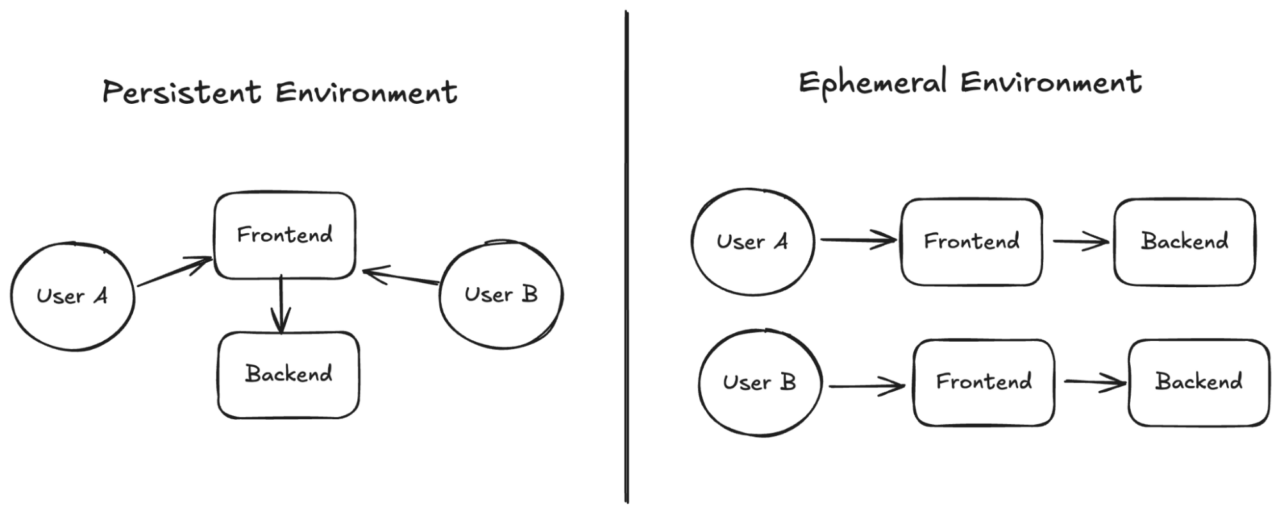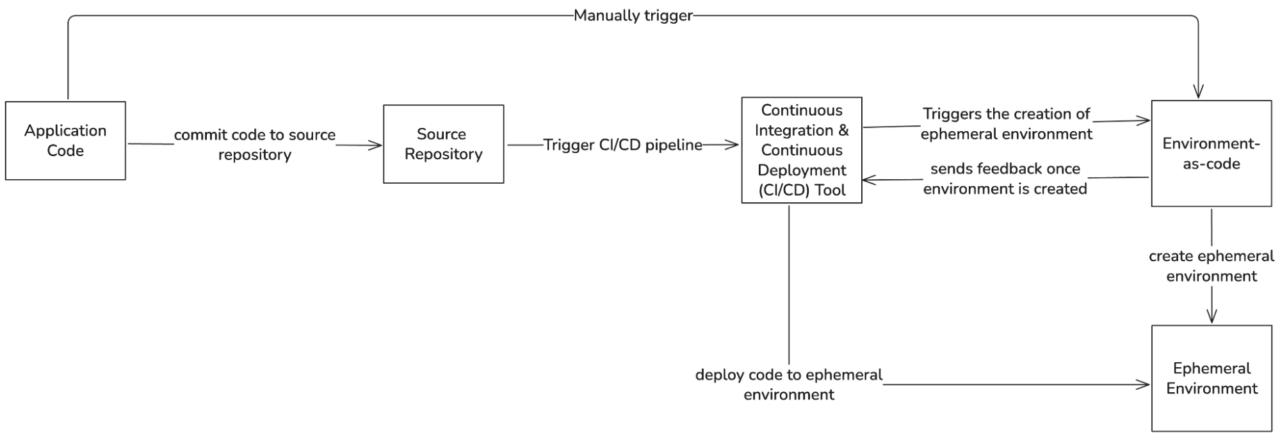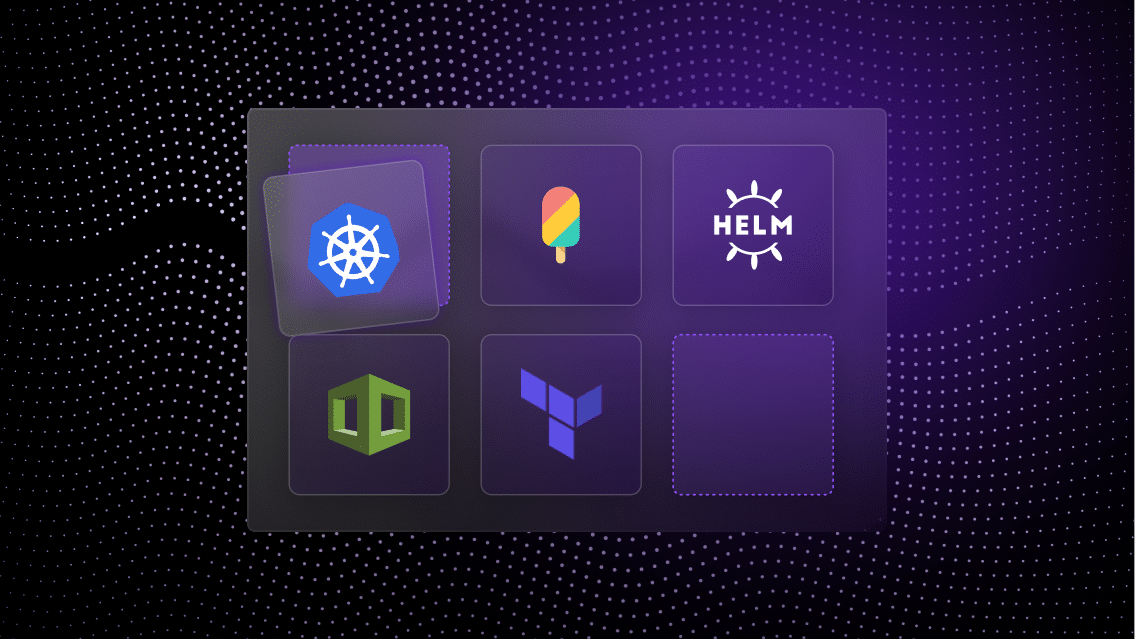Ephemeral environments are increasingly preferred by DevOps and platform engineering teams who want to optimize for agility and minimize waste in the cloud.
These environments typically involve on-demand, temporary setups best suited for non-production use cases like development, testing, staging, and quality assurance (QA).
This article outlines how platform engineering teams are successfully utilizing ephemeral environments with platforms such as Quali Torque. By the end of this article, you should be able to take away actionable recommendations for building, managing, and optimizing ephemeral environments within your development teams.
Understanding ephemeral environments
Ephemeral environments are temporary, on-demand environments provisioned and decommissioned automatically for a specific purpose. While they’re primarily used in non-production stages of the software delivery lifecycle, they offer developers, testers, and QA engineers isolated environments that closely mirror production systems—without the overhead or risk associated with maintaining long-lived environments.
As cloud-native practices, GitOps, and CI/CD pipelines have all matured, ephemeral environments have become a core enabler of agile software delivery practices. For a dev team transitioning to microservices architectures or platform engineering models, ephemeral environments play a crucial role in maintaining velocity and minimizing unwanted infrastructure sprawl.

Figure 1. Persistent environment vs. ephemeral environment
Ephemeral environments are defined and provisioned using an environment-as-code model. They are enforced with automated policies, and triggered by various events such as pull requests, executing a suite of tests, or even time-based triggers.
Why ephemeral environments require environments as code
Ephemeral environments require an environment-as-code approach because traditional tools like infrastructure as code (IaC) are often insufficient on their own. While IaC is excellent at defining individual cloud resources, it falls short when dealing with the complexity of complete, multi-component environments needed for development, testing, or staging.
When users need to deploy these environments, which typically involve multiple infrastructure components, services, and configurations, relying solely on IaC means they must manually provision and configure each resource individually. This process is time-consuming, error-prone, and doesn’t scale well.
Environment as code addresses this challenge by providing a single, cohesive definition, often a single file or a set of related files that encapsulates all the infrastructure, services, dependencies, and configurations required to run a complete environment. Instead of managing individual pieces, users can deploy the full environment simply by executing this environment code.
This holistic approach is crucial for the ephemeral nature of these environments. It enables the lifecycle automation needed for users to automate both the provisioning and the termination of an entire environment as a single unit. This ensures environments are created consistently and torn down reliably when no longer needed, delivering the core benefits of cost savings and agility, while also making them significantly easier to manage at scale.

Figure 2: Automated provisioning of ephemeral environment
What defines an ephemeral environment?
Ephemeral environments possess several key characteristics:
- Transient/automated: They are created and destroyed automatically as part of a workflow or lifecycle.
- Trigger-based: The creation and destruction of these environments are driven by CI/CD pipelines, Git events, or user actions.
- Defined as code: They are provisioned from reusable blueprints for the environment, ensuring a consistent experience and reducing provisioning overhead.
- Isolated/reproducible: These environments provide a safe, clean, and repeatable space for testing or validating applications.
Pros & cons of ephemeral environments
Ephemeral environments, as opposed to conventional static environments, are set up as needed and automatically destroyed when no longer required. This model minimizes wasted resources and creates a clean slate for development or testing with every instance.
When utilized appropriately, ephemeral environments provide some key advantages.
Cloud cost optimization
Ephemeral environments help software teams eliminate unnecessary cloud costs. Environments are destroyed when no longer needed, reducing costs associated with resources running during off-hours like weekends or overnight.
Flexibility and speed
Teams can access live environments when needed. This eliminates bottlenecks, increases velocity, and enables conflict-free parallel operation across multiple teams.
Reduction in drift
Ephemeral environments reduce the sprawl and drift typical of always-on development environments. Automated policies and standard templates help maintain repeatability and compliance.
Despite their benefits, many platform teams face challenges when trying to implement ephemeral environments at scale. Some common concerns include:
- Creating environment templates: The platform team often struggles to create environment templates that mirror realistic production environments.
- Managing lifecycle: Aligning the lifecycle of environments with business hours or activity can be difficult.
- Tracking utilization: Ensuring environment utilization is appropriate for its intended purpose can be a challenge.
- Policy drift and governance: Ensuring ongoing policy adherence and governance over time requires continuous oversight.
Common use cases for ephemeral environments
Ephemeral environments are valuable across a variety of use cases:
- Testing feature branches: Developers can deploy a pull request into an ephemeral environment to validate changes before they’re merged into the main codebase.
- Ensuring integration and system testing: Ephemeral environments allow for the reliable testing of integrations in an environment similar to production, without impacting users.
- Staging or pre-production: These environments serve as the final step before going live, letting teams verify that everything works as intended without introducing risks to users or other environments.
- Workshops, demos, and onboarding: Ephemeral environments can be provisioned concurrently and identically for training or demo purposes, ensuring all participants have the same setup.
Strategic significance of ephemeral environments in the cloud
Aside from the pros of using these environments discussed above, there are additional strategic benefits to consider for cloud-native infrastructure:
- Cloud strategies: Ephemeral environments are becoming a crucial enabler as modern cloud strategies focus on automation, efficiency, and agility.
- DevOps and GitOps: They facilitate quick feedback loops, infrastructure reuse, and cost-effective scaling, making them ideal for DevOps, GitOps, and platform engineering models.
- Infrastructure control: Teams gain more control over when and how infrastructure is used in ephemeral environments, ensuring that cloud investments yield maximum value.
- Alignment with FinOps and cost optimization: As FinOps and cloud cost optimization initiatives gain traction, ephemeral environments help ensure efficient resource usage and cost management.
Navigating the challenges of ephemeral environments with Quali Torque
Quali Torque simplifies the orchestration, provisioning, and management of cloud infrastructure and environments so that your DevOps and platform teams can focus on more important work.
Automate the creation of reusable cloud assets
Creating an ephemeral environment each time a developer generates a pull request (PR) or someone starts a test suite may become tiring if the developers have to script those environments manually. Organizations that run in cloud environments with varying resources and dependencies are not in a position to script each environment from scratch.
Instead, successful teams use Quali Torque’s automation to generate reusable cloud assets:
- Create infrastructure as code from existing resources: Torque users first look at existing cloud environments and automatically convert them into reusable IaC modules. This reduces the barrier to adopting ephemeral environments and promotes infrastructure as code as a key practice in DevOps.
- Generate blueprints with AI assistance: Rather than manually scripting complex environments, users rely on Torque’s AI capabilities to orchestrate existing modules into functional blueprints. These blueprints define an environment’s structure, components, dependencies, and lifecycle.
- Package and share environment-as-code modules: With blueprints, teams can reuse definitions across multiple projects and environments, ensuring consistency and saving time.
By reducing the manual overhead of environment creation, you can scale your ephemeral environments to match team and project demands without additional scripting effort. This is especially important for platform engineering teams that support multiple development teams with varying needs.
Automate the lifecycle for ephemeral environments
Creating environments is only half the battle. Many of the cost savings associated with ephemeral environments come from making sure they’re actually destroyed when they’re supposed to be. Failure to do this promptly, whether due to human error or lack of attention, will leave the environment running longer than required, causing unnecessary cloud expenses.
Platform teams that succeed with ephemeral environments use automation to define and enforce lifecycle behavior. Quali Torque can help with this by:
- Defining lifecycle rules as code: With Torque, users codify the start and end times of environments directly within their blueprints. This ensures predictable and consistent runtime behavior.
- Scheduling deployment and teardown with cron or triggers: Certain users establish cron-based rules that kick off environments during work hours and shut them down after work hours. Others bind lifecycle events to Git activity, like tearing down environments once a pull request has been merged.
- Avoiding idle costs automatically: Automated teardown ensures environments don’t persist beyond their usefulness, reducing wasted spend and resource contention.
These practices enable teams to build and test applications while lifecycle automation takes care of controlling cost and resource management in the background. DevOps and platform engineering teams can then benefit from operational efficiencies while maintaining governance.
Create and enforce policies on maximum runtimes
When ephemeral environments grow across teams, governance becomes essential. Even with automation, teams are still able to bypass limits at runtime, create environments they are not authorized to create, or forget to tear down environments.
In the absence of enforcement, ephemeral environments can quickly lose their value. To prevent this, DevOps and platform teams using Torque can implement guardrails:
- Define policies with Terraform and Rego: Maximum runtimes, allowed instance types, and access controls are specified in code and version-controlled for auditability. This integrates with existing IaC workflows.
- Use RBAC to control who can create or modify environments: Role-based permissions ensure only authorized users can extend or override environment behavior.
- Tag resources consistently: Teams apply tags that define the environment purpose, owner, and cost center. This supports FinOps practices and enables precise billing analysis.
- Enforce with policy engines: Torque integrates with policy engines like OPA to apply rules in real time, blocking non-compliant environments at the source.
These policies help maintain the ephemeral nature of environments, keeping them from turning into persistent, unmanaged infrastructure. They ensure that even in fast-moving DevOps environments, policy and compliance are not compromised.
Track effectiveness and prevent policy drift
Implementing ephemeral environments is not a one-time effort. Over time, policies may drift, usage patterns may change, and visibility can decline. To sustain the value of ephemeral environments, platform engineers must track effectiveness continuously.
Teams using Quali Torque can effectively:
- Monitor activity and usage: Dashboards track how many environments are created, how long they last, and who uses them, allowing teams to understand whether environments are delivering the expected value.
- Visualize cloud costs per team and project: Integrated reporting shows cost trends and usage across business units, allowing for cost breakdowns and budgeting.
- Detect configuration drift: Monitoring tools alert teams when environment configurations deviate from the defined blueprints or approved runtime limits.
- Enforce compliance in real time: Policy drift is caught early using Torque’s enforcement mechanisms, ensuring environments remain aligned with organizational standards.
This continuous feedback loop ensures ephemeral environments continue to serve their purpose while evolving with the organization’s needs. It reinforces DevOps best practices and helps platform engineering teams maintain standards at scale.
To learn more, check out our webinar on “Optimizing Cloud Costs with Ephemeral Environments.”
Conclusion
Ephemeral environments are a compelling option for increasing the agility, efficiency, and governance of cloud workloads that are not in production. They facilitate rapid iteration for development and testing teams while keeping idle resources minimized.
However, developers can only enjoy these benefits after they address the challenges of adopting ephemeral environments. The true “unlock” for scaling ephemeral environments lies not just in provisioning them, but in overcoming the ongoing operational burden associated with their lifecycle management, policy enforcement, and continuous optimization. Specifically, the platform team needs to automate the provisioning of environments, reliably manage their life cycle, enforce running limits, and measure effectiveness.
As discussed throughout the article, using Quali Torque can help overcome these challenges. It replaces manual work with automation, enforces policies that govern their cloud use, tracks utilization, and improves cloud costs automatically.
By integrating Quali Torque into your cloud cost management fabric and applying these methods, your teams can create an ephemeral environment that is consistent, secure, and sustainable. In turn, you can ship faster, spend smarter, and operate more reliably in the cloud.
To see for yourself how Torque works, request a free trial or visit our Playground today.

